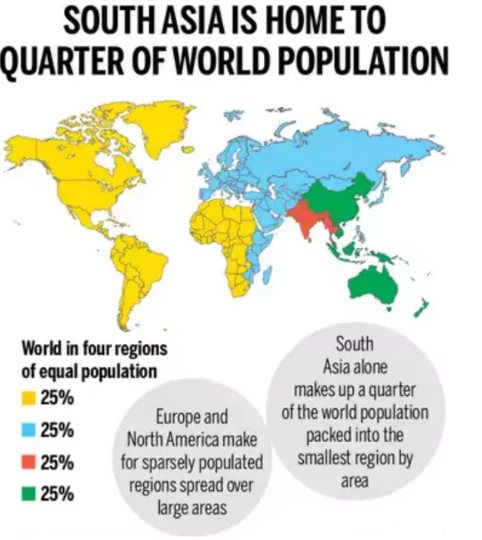19 November 2024 : Indian Express Editorial Analysis
1. Neighbourhood first, in practice
(Source: Indian Express; Section: The Ideas Page; Page: 13)
| Context: |
| The article criticizes India’s muscle-flexing foreign policy in South Asia, advocating for a more cooperative, respectful, and neighborly approach to foster regional stability and goodwill. |
About South Asia

- South Asia is home to one of the world’s earliest known civilizations, the Indus civilization, and today is one of the most densely populated regions on the planet. South Asia’s people are its biggest asset but remain wastefully underutilised.
- Comprises: South Asia includes the countries of Bangladesh, Bhutan, India, Pakistan, Nepal, and Sri Lanka; Afghanistan and the Maldives are often considered part of South Asia as well.
- The term is often used synonymously with “Indian subcontinent,” though the latter term is sometimes used more restrictively to refer to Bangladesh, India, and Pakistan.
India’s “National Interest” in the Neighborhood
- India’s national interest in its neighborhood involves maintaining stability, fostering cooperative relationships, and safeguarding its sovereignty while promoting regional growth.
- However, defining this interest solely in terms of dominance and muscle-flexing can be counterproductive.
- A focus on establishing India as a benevolent regional leader through mutual respect and non-interference would yield better long-term results.
The Pitfalls of Muscle-Flexing Diplomacy
- The notion of asserting dominance through aggressive diplomacy has left India in a precarious position. Far from creating a zone of influence, this approach has strained relationships with most of its neighbors.
- Current geopolitical dynamics, including China’s strategic entry into South Asia, have made such dominance unfeasible. Countries like Nepal, Maldives, and Sri Lanka have increasingly sought to counterbalance India by strengthening ties with China.
- Flexing muscles in such a scenario only exacerbates anti-India sentiment, leaving India neither feared nor respected.
The Importance of Public Scrutiny in Foreign Policy
- India’s foreign policy traditionally operates behind closed doors, often under the assumption that it is best left to experts and diplomats.
- However, this lack of public scrutiny may lead to decisions that do not reflect the broader public interest.
- Introducing transparency and accountability in neighborhood policy, akin to how individuals manage relationships in communities, could ensure a more grounded and empathetic approach to diplomacy.
Challenges with Current Regimes in the Neighborhood
- Recent changes in South Asia’s political landscape have compounded India’s diplomatic challenges. Leaders in Nepal, Bangladesh, Maldives, and Sri Lanka have adopted stances that reflect growing dissatisfaction with India.
- While the Modi government cannot be solely blamed for this, historical baggage and perceived interference have deepened the resentment.
- For example, the 2015 Nepal blockade continues to haunt India-Nepal relations, symbolizing a heavy-handed approach that alienated even pro-India segments in Nepal.
Historical and Cultural Bonds: A Missed Opportunity
- India shares deep cultural, historical, and economic ties with its neighbors, particularly Nepal, which could serve as a foundation for collaboration.
- However, India’s perceived “big brother” attitude, coupled with inconsistent policies, has eroded goodwill.
- A shift towards genuine partnership and respect for Nepal’s sovereignty could mend strained ties, but this requires India to introspect and recalibrate its approach.
The Gujral Doctrine and the Path Forward
- Former Prime Minister Inder Kumar Gujral’s principle of not seeking reciprocity in bilateral relations with smaller neighbors offers a blueprint for India’s neighborhood policy.
- By prioritizing respect for sovereignty, non-interference, and peaceful dispute resolution, India could foster goodwill and stability.
- Adopting a “neighborliness first” policy, rather than asserting power claims, would emphasize India’s role as a cooperative and dependable partner.
Evaluating the Efficacy of Current Policies
- India’s current policies have often failed to achieve desired outcomes. Despite investments in infrastructure and aid, anti-India sentiment remains pervasive in the region.
- A reorientation towards transparent, respectful, and inclusive diplomacy could yield more sustainable benefits. Ultimately, India must redefine “national interest” to prioritize mutual benefit and long-term regional stability, recognizing that being a good neighbor is both pragmatic and prudent.
Whose Interest is “National Interest”?
- The core question is whether India’s foreign policy serves the broader public interest or the priorities of a select few.
- A genuine pursuit of national interest would entail creating a peaceful, cooperative regional environment that aligns with the aspirations of people both within and beyond India’s borders.
| India’s Challenges in South Asia |
|
Following are the various challenges faced by India that need to be considered and tackled. Kashmir as the Unfinished Agenda: Pakistan sees the Kashmir question as the unfinished agenda of Partition and is not willing to put it aside even temporarily to develop a limited but positive engagement with India and facilitate South Asian regional integration under the auspices of SAARC. Economic Partitions and Political Barriers: The Subcontinent’s political partition was paralleled by an economic divide, as India and its neighbours embraced autarky, reinforcing borders as both political and commercial barriers. Akhand Bharat Vision: The Rashtriya Swayamsevak Sangh (RSS) version of “Akhand Bharat” or “Greater India” or the liberal version of an integrated Subcontinent are both viewed with deep suspicion. The neighbouring elites see a fundamental contradiction between a regional order led by India and their national sovereignties. Rise of Politically Anti-India Regime: Various neighbouring countries expressing the rise of politically anti-Indian regime such as Maldives, an anti-India in an instrumental sense, the newly elected government was effectively asking Indians to pack up and leave. Also, in Bangladesh, the Bangladesh Nationalist Party (led byKhaleda Zia) is ideologically anti-India. China’s Footprint in South Asia: China’s Belt and Road Initiative (BRI): Many South Asian countries are increasingly entangled in Chinese infrastructure projects. China’s Outreach: China outreach to South Asian states when the rest of the World abandons or avoids them such as during Taliban-led Afghanistan, military-ruled Myanmar and crisis-hit Sri Lanka highlights its growing influence. Border Settlements: China’s desire to settle border disputes with its neighbours (minus India), as seen in the case of Bhutan, further strengthens its regional ties. Influence of Other Countries: The influence of the Middle East — Qatar, Saudi Arabia, Turkey, and the United Arab Emirates — is rising amidst their growing economic and military capabilities in South Asia. |
| PYQ: ‘China is using its economic relations and positive trade surplus as tools to develop potential military power status in Asia’, In the light of this statement, discuss its impact on India as her neighbor. (150 words/10m) (UPSC CSE (M) GS-2 2017) |
| Practice Question: Critically analyze India’s foreign policy approach towards its neighbors in the context of increasing anti-India sentiment in South Asia. Should India prioritize a ‘neighborliness first’ approach over dominance in its regional diplomacy? Discuss with examples. (250 words/15 m) |




